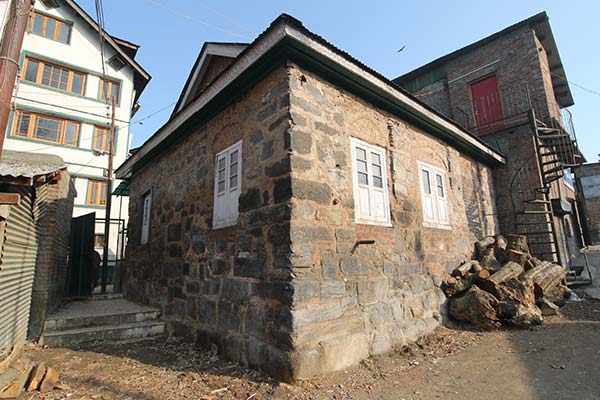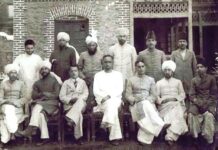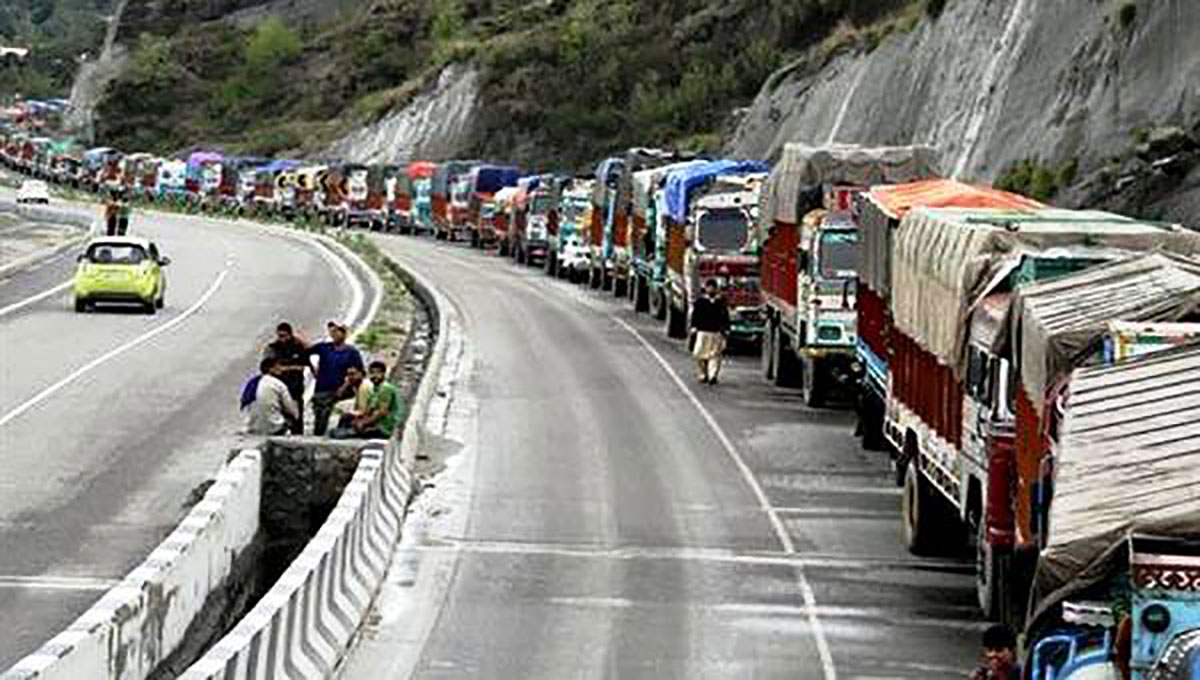As the internecine fighting between feudal lords and kings triggered an unending appetite for Turkish mercenaries, Muslims from the neighbourhood trickled in as traders, fighters, refugees, and preachers. Once Mongols levelled Kashmir to a new low, some immigrants resurrected Kashmir under a new faith without locals, writes Sara Wani

Witnessing Mahmud Ghaznavi’s second attempt to conquer Kashmir fail outside the Loharkot fort in Poonch in 1021 AD, Arab historian Abu Al-Rahain Muhammad Ibn Ahmad Alberuni saw the Vale living beyond “impenetrable regions”. Apparently watching Kashmir from a peak, where “snow never melts”, he has recorded the state of security in which Kashmir lived: “The fortress Rajagirı lies south of it (the peak), and the fortress Lahur west of it, the two strongest places I have ever seen.”
Describing Kashmiris’ as “pedestrians” lacking riding animals and elephants and carrying their nobles in Katt’s on their shoulders, al-Beruni was, however, impressed by their sense of security. “Kashmiris are particularly anxious about the actual strength of their country, and therefore take always great care to keep a stronghold upon the entrances and the roads leading to it. In consequence, it is very difficult to have any commerce with them,” he recorded in Alberuni’s India, almost a decade later. “In former times they used to allow one or two foreigners to enter their country, particularly Jews, but at present, they do not allow any Hindu whom they do not know personally to enter, much less other people.”
That Kashmir did not last long. As kings were challenged by Damara’s, Kashmir remained usually tense. In A History of Kashmir, historian P N K Bamzai records Damaras, the landholding barons, emerged quasi-independent and would operating from Parvesanas’, the fortified residences, akin to castles of the medieval feudal lords, and would undermine the king’s authority. “By the twelfth century, the Damaras had become very powerful,” records Bamzai. “Sussala and Jayasimha spent the major part of the reign in fighting them, but did not succeed in completely breaking their power.”
They grew powerful, defied royal authority and by their constant revolts plunged the country into confusion. “Life and property were not safe, agriculture declined, and there were periods when trade came to a standstill,” records Mohibbul Hassan in his Kashmir Under The Sultans.
This raging battle for authority kept the avenue open for Turkish mercenaries and warriors. Apart from foreign expeditions, the weak Hindu kings would utilize them in consolidating their power at home especially against Damaras.
That was precisely why the exploitative king Suhadeva (1300-1 to 1319-20 AD) failed to garner any support in defending his kingdom when Dulchu invaded Kashmir through Jhelum Valley Road (1320). “He fled to Kishtwar, leaving his people to the mercy of the invaders who perpetrated all kind of atrocities upon them,” records Mohibbul Hassan. “They set fire to the dwellings, massacred the men and made women and children slaves.”
After eight months, scarcity of rations led Dulchu to flee Kashmir with fortunes and tens of thousands of Kashmiri slaves and perished over the peaks. “When Dulchu had left the place, those people of Kashmir who had escaped capture issued out of their strongholds as mice do from their holes,” records Jonaraja. “When the violence caused by Rakhsha Dulchu ceased the son found not his father nor the father his son, nor did the brother meet his brother. Kashmir became region before creation, vast field with men without food and full of grass”.

Power vacuum had engulfed the terrorized and grieving Vale. But four persons from diverse backgrounds who had immigrated during Suhadeva’s reign were destined to fill the vacuum: Lankar Chak, Shah Mir, Bulbul Shah and Rinchana. Their intervention in a devastated Kashmir changed it forever.
Chak was a Dardistan resident whom his brother had defeated back home. Suhadeva rehabilitated the Chak family in Trehgam.
A Persianized Turk, Shah Mir was a job seeker from Swat who was bestowed with a village in Jagir in Baramulla in 1313.
Sharief-ud-Din Abdul Rehman, Kashmir’s Bulbul Shah, who must have stayed in Alikadal, the Mleechmar of yore, and perhaps Islam’s first address in Kashmir.
Ladakh prince Lha-Chen-Rgyal-bu-rin-chen alias Rinchina had escaped from Baltis who had assassinated his father. With the permission by Suhadeva’s army chief Ramacandra, he settled in distant Gagangir near Sonamarg after descending from Zoji La at the peak of Dulchu’s devastation. He earned respect for protecting people from robbers.
“The only place that remained partially safe from the fury of the Mongols was the district of Lar, where Ramacandra shut himself up in the fort, and endeavoured to protect his family, his followers and the inhabitants of the town and the neighbourhood,” according to Mohbbul Hassan. Credited for maintaining “some semblance of authority”, Ramacandra, post-Dulchu retrieved Andarkot, the Kashmir capital located near Sumbal, from Kishtwari Gaddi’s, who had occupied it.
But Ramacandra’s bid to takeover a devastated Kashmir was short-lived. Rinchana assassinated him in Lar fort and seized power. He married his daughter Kota Devi and granted a high position to her brother Rawancandra. Shah Mir helped him achieve the target. That was the fall of 1320.
Rinchana was Buddhist, a faith Kashmir had given up much earlier. They were Hindus but caught in the exploits of clergy and the throne. Personally disillusioned with his faith, Kashmir’s first non-local king wanted a unifying factor for his newly acquired kingdom and subjects. By embracing Islam eventually he became the first high-profile convert. His conversion is accepted by all but reasons and means are contested.
In Rajataragini, Jonaraja says Rinchana wanted to become a Hindu and at the behest of Kotarani, the queen, Brahmins were approached. But the Shaiva guru Devaswami refused to admit him into the fold, he says. “Conversion from Buddhism to Hinduism or vice versa was not a new thing”, historian Prof A Q Rafiqi points out in the UNESCO study, insisting that Rinchana, being the king, could have approached any other Brahman to do the honours.
Mohibbul Hasan terms Rinchana a truth-seeking inquisitive whom neither a diluted Buddhism offered any solace nor the caste-ridden Hinduism and arrogant Brahmans appealed. “As a result he was troubled and restless, and passed sleepless nights, weeping and praying to God to guide him to the right path,” Hasan quoted Baharistan-e-Shahi saying.
Most probably Shah Mir’s companionship might have influenced him to Islam, an escape from the suffocating and prejudiced Brahmanical and Buddhist surroundings. In Kashmir’s Transition to Islam, Prof Isaq Khan disputed Rinchana’s conversion to Islam for his political ambition and association with Shah Mir. He converted at the hands of Bulbul Shah, his spiritual guru.
Then, Bulbul Shah was no stranger. A Sufi from Suhrawardiya order, he was a Turkistan national and had visited once before making Kashmir his home. Then, he accompanied traders and returned. Tibetan scholar and archaeologist of Moravian Mission A H Francke has traced two folk songs – Song of Bordo Masjid, in Ladakh – Chuchoot and Shay, indicating Bulbul Shah’s passage through the desert. On this basis, they believe, the mosque at Shay, in outskirts of Leh – considered the oldest in J&K, might have been set up by Bulbul Shah and not by Amir-e-Kabir Mir Syed Ali Hamadani. The latter only prayed in this mosque during one of his three travels to Kashmir, they believe.
His second visit was recorded in Suhdeva’s reign when, according to Muhibbul Hasan, he entered Kashmir “with one thousand fugitives from the Mongol invasion”.
After bringing in the first high-profile convert to Islam, the Turkish preacher named Rinchana, Sadruddin. Royal endorsement to the new faith led to many conversions in the court and to “ten thousand” commoners, according to some references quoted by G M D Sufi in Kashir: Being A History of Kashmir. The king set up Bulbul Langhar (Lankar), a three-storied wooden hospice (Khanqah) for the gathering of new converts, and, according to Mohibbul Hasan “endowed it with a number of villages, whose income was to be spent for supporting its servants and supplying food to the travellers and the poor”.

In their jointly authored Mukamal Tareekh-e-Kashmir (vol 2), Mohammad Din Fouq and Sheikh Mohammad Hussain Haidri have recorded the villages endowed for managing the expenses of the Langhar, the community kitchen, were in Nagam belt and continued till the Chagtai era. “Among the buildings of Muslims, there were the foremost ones – the hospice, and the mosque,” Fouq has recorded. “In close vicinity towards the north of the khanqah, Sadruddin built his palace and a Jamia Masjid adjacent to it.” This palace disappeared and the mosque went up in flames but was reconstructed at a small scale and is still known as Rinchan (Reanton) Masjid, Fouq wrote in 1910.
Quite adjacent to it came up Kashmir’s first mosque that went up in smoke many times and rebuilt. The small one-room mosque rebuilt with stones and concrete recently on the banks of Jhelum is closed for prayers. After establishing Islam firmly in Kashmir, Bulbul Shah died in 1327. Francke discovered his grave near his Ali Kadal mosque on the banks of Jhelum in 1909. It lacked an epitaph and devotes set up a mausoleum. In 2011, state government sanctioned nearly two crore rupees that led to the demolition of the old structure to create a concrete-brick-wood complex against the advice of the heritage experts.
Bulbul Shah outlived the converted king who died of a head injury in 1323 but failed to impress his queen Kotarani who remained a Hindu. Initially, supported by Lavanyas, the small rural landlords, Kotarani wanted to rule Kashmir as Reagent of her minor son Haider, then being raised by Shah Mir. But big landlords wanted Udhyanadeva to be summoned from Swat. Brother of Suhadeva, this coward had also fled Kashmir during the Dulchu invasion. He returned, was given power in 1323 and Kotarani married him. They had a son Bola Rattan, according to Jonaraja.
Udhyanadeva was a puppet. He wore the crown and the queen exercised the control over him and his state. Soon after assuming office, a Turkish incursion (led by Urdil as Persian records suggest or Achala if one goes by Jonaraja) took place near Hirapur, the king fled to Ladakh to save his skin. Kotarani united people against invaders with the help of Shah Mir and Bhatta Bhiksana, her foster brother, also her son Bola’s custodian. Turks were defeated.
When Udhyanadeva returned, Kotarani restored his status. Disgraced king preferred seclusion leaving Kotarani to run the state for 15 years as the last Hindu ruler of Kashmir. Shah Mir did not take this lightly. Though his sons Jamshed and Ali Sher were Udhyanadeva’s governor for Maraj (south Kashmir) and Kamraj (north Kashmir), he started planning her overthrow with the active support of the Kotarajas.
Udhyanadeva died in 1338 and Kotarani declared herself sovereign ignoring both her sons. She appointed Bhiksana as her minister. By then, Bamzai says, Shah Mir’s influence in Srinagar was growing “because of his abilities and the sympathies with and understanding of grievances of the people”. A threatened Kotarani fled Srinagar and shifted her seat of power to Anderkot spurning Shah Mir’s offer of power-sharing through matrimonial alliance (some historians have called Shah Mir Kota’s paramour).
Aggrieved Shah Mir first treacherously murdered Bhiksha and then advanced to Anderkot with a renewed marriage proposal. She agreed and surrendered. The septuagenarian king arrested her after she entered her nuptial chamber with a dagger hidden in her dress to murder him. She was thrown into prison with both her sons. Romantic Kota, Kashmir’s last Kashmiri sovereign died in prison in 1339 without anything on record about her Muslim and the Hindu sons.
Ascending the throne as Sultan Shams-ud-Din in 1339, Shah Mir, the Swat job-seeker, founded the first Kashmiri sultanate that reigned for two centuries. He employed Lankar Chak as his army chief and accommodated Magres (Magray caste) from the host population in his power structure.
Crushing destabilizing Damaras and Lavenayas, Shah Mir restored order, paid attention to agriculture, the mainstay of the economy, abolished some taxes and oppressive laws, according to various credible sources Hasan has quoted. Bamzai credits Shah Mir for conducting “the affairs of the state in a wise and statesmanlike manner” unlike Hindu “atrocious tyrant” kings whose “avowed policy had been to leave to their subjects nothing beyond a bare subsistence”.
Islam was court religion but not much changed on the ground. The Hindu majority country had Sanskrit as the official language as Brahmans, the traditional official class, ran the Sultanate that ruled from Sumbal. The retention of Hindu faith was neither a bane nor converting to new faith a boon in his court. He introduced Laukika calendar beginning with Rinchana’s ascension and conversion to Islam and Kashmir durbar abandoned it when Mughals took over. Leaving the young sultanate to his two of the four quarrelsome sons, Shah Mir died in 1342 and was buried near Anderkot.
Jamshed, his elder son ruled for almost a year till his brother Ali Sher alias Alauddin dethroned him in 1343 and ruled for 11 years. His social interventions included promulgating a law denying any inheritance to an issue-less widow from her husband if she is immoral, according to Jonaraja. He improved Anderkot and founded Alauddin Pora in Srinagar where he lays buried since 1354.
Statecraft and not faith was Sultanate’s priority. “The founders of the new ruling dynasty and his successors, Jamshed and Alaudin,” says Ishaq Khan, “were more concerned with restoring law and order in Kashmir than devoting themselves to the religious affairs of a small number of their Muslim subjects living peacefully in Hindu-Buddhist surroundings.”
(This is the third part of the four-part series on the advent of Islam in Kashmir. It was slightly modified after it was printed. The second part of the series is Kashmir’s Mlecch Era)















